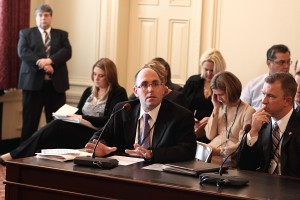Obama CEO Summit Explains EPA Regulatory Retreat

Obama in Harrisburg, Pa. during campaign (4/19/08). Are we “on track for change” yet?
[Update 2 – 12/23/10 – here’s another example, Wall Street Journal: EPA Puts Some Greenhouse-Gas Rules on Hold]
Update 1: 12/20/10 – We see another major EPA fold on the horizon. EPA Administrator Lisa Jackson wrote a letter to incoming House Energy and Commerce Chairman Fred Upton (R-Mich.) on EPA’s pending regulations implementing Clean Water Act Section 316 cooling towers – read Jackson’s letter – and see our views here]
Growing more republican every day, last Thursday, the New York Times reported that the Obama EPA was walking away from major regulations, just at the critical moment when EPA needed to ramp up regulations to address global warming in light of Republican intransigence and global warming denial in Congress.
E.P.A. Delays Tougher Rules on Emissions
The Obama administration is retreating on long-delayed environmental regulations new rules governing smog and toxic emissions from industrial boilers as it adjusts to a changed political dynamic in Washington with a more muscular Republican opposition. …
The delays represent a marked departure from the first two years of the Obama presidency, when the E.P.A. moved quickly to reverse one Bush environmental policy after another. Administration officials now face the question of whether in their zeal to undo the Bush agenda they reached too far and provoked an unmanageable political backlash.
Environmental advocates are furious. They fear a similar delay on the approaching start of one of the most far-reaching regulatory programs in American environmental history, the effort to curb emissions of carbon dioxide and other greenhouse gases.
But in a striking turnabout, the National Association of Manufacturers and the American Petroleum Institute which have been anything but friendly to Mr. Obama are praising his administration.
“Clearly, the agency has heard the calls from manufacturers” said Keith McCoy, vice president for energy and natural resources at the manufacturers’ group. “We hope this week’s announcements signal that the E.P.A. is slowing down on overly burdensome and unnecessary rules that will crush economic growth and job creation.”
Today, the Wall Street Journal reports the larger political context and industry agenda:
Obama to Convene CEO Summit
WASHINGTON – President Barack Obama will convene a one-day summit of corporate chief executives Wednesday as part of a renewed White House effort to build support among business leaders for his economic agenda. …
… Presidential adviser Valerie Jarrett said, as would ideas for “a balanced approach to regulations “to promote economic growth and give business regulatory certainty and predictability while providing safety for the American people,” she said. …
The agenda Wednesday reflects concerns expressed in a “Roadmap for Growth” sent to the White House last week by the Business Roundtable. About 80 chief executives in Washington for a Roundtable meeting showed renewed optimism that Mr. Obama was serious about tackling their concerns, Ms. Schneider said.
In addition to promoting wildly destructive growth in energy demand, here’s some of what the “Roadmap for Growth” says about environmental regulations (I urge you to read the whole thing):
Unfortunately, over the past year-and-a-half, the EPA has indicated that it will propose a series of new, tighter regulations on the emissions of sulfur dioxide, nitrogen dioxide, ozone, particulate matter, mercury, GHGs and coal ash, as well as tighter regulation of chemicals under the Toxic Substances Control Act.
This avalanche of new, more stringent regulations will create additional costs for both existing and new facilities and increase uncertainty. In particular, the EPA’s proposal to regulate GHGs under the Clean Air Act threatens to impose additional costs on U.S. manufacturers while doing little to reduce global GHG emissions. The economic impacts on areas that do not meet EPA air standards will be significant, constraining economic activity and job growth. To meet its proposed ozone standard, for example, the EPA estimates that compliance costs will range from $19-90 billion.
As the U.S. manufacturing sector continues to struggle and shed jobs, the EPA’s actions will impose additional expenses on U.S. manufacturers, adversely affecting American workers and placing U.S. companies at a competitive disadvantage to foreign firms. EPA’s regulatory agenda needs to be reassessed. Proposed regulations should be more carefully calibrated to ensure that they are cost-effective, achievable, rooted in the best science, coordinated with available technology and do not unreasonably impair our economic growth or energy security.
Based on a close following of her NJ experience, during the Senate confirmation process, we tried to warn folks that Lisa Jackson had no spine and would bow to political winds (see: WHY LISA JACKSON SHOULD NOT RUN EPA – Disastrous Record in New Jersey Bodes Ill for Reforming EPA

Lisa Jackson testifies to US Senate Environment Committee during EPA confirmation hearing (1/14/09)
I hate to say I told you so, but here is the money quote:
DEP employees describe Ms. Jackson as employing a highly politicized approach to decision-making that resulted in suppression of scientific information, issuance of gag orders and threats against professional staff members who dared to voice concerns. These reports raise troubling questions about her fitness to run an agency of much greater size and complexity…
“In our experience, Lisa Jackson is cut out of the same professional cloth as the current administrator, Stephen Johnson “ a pliant technocrat who will follow orders,” Ruch added. “If past is prologue, one cannot reasonably expect meaningful change if she is appointed to lead EPA.”
The one area where Ms. Jackson claims national leadership is the state climate change program but PEER contends that examination of her record yields paltry results:
- DEP failed to meet its first major statutory milestone in implementing the emission reduction goals of the highly touted Global Warming Response Act. A June 30th legal deadline for producing a plan identifying the legislative and regulatory measures necessary to reduce greenhouse gas emissions still has not been met. At the same time, Ms. Jackson supported and Gov. Jon Corzine signed “The Permit Extension Act†which exempts thousands of projects from any new energy conservation, efficiency or requirements for solar heating or renewable energy;
- New Jersey missed the historic first auction of greenhouse gas pollution allowances under the Regional Greenhouse Gas Initiative, or RGGI, this September because DEP was unable to adopt regulations to implement the pollution trading program that underpinned the auction; and
- Jackson proposed a cap-and-trade program to reduce carbon dioxide emissions that will do little to combat global warming because it sets emissions caps above current levels and contains numerous complex offsets and loopholes that undercut its effectiveness.
“Given what actually transpired in New Jersey, putting Ms. Jackson in a key position for guiding a national global warming effort would be imprudent”
More recently, we also predicted that Jackson’s EPA would yield to White House pressure and fold on the coal ash impoundment issue (see: EPA Caves on Coal Ash Regulation)
We predicted Jackson’s political style and EPA’s failure to reform political attacks on scientific integrity (see: News You Won’t Get From The Hometown Cheerleaders
We reminded folks that despite opposing drilling while NJ DEP Commissioner, Jackson quietly went along with Obama’s disasterous decision to expand off shore oil drilling, just weeks before the BP Gulf blowout. We wrote:
Lisa Jackson’s January 25, 2007 testimony to US Senate Energy and Natural Resources Committee (@ page 18)- opposed off shore drilling based on based on Virginia location and proximity to NJ beaches – did she give Obama the same advice?:
“I would like to reaffirm the State of New Jersey’s opposition to oil and gas lease sales for areas off the coast of New Jersey, as well as the opening of the mid-Atlantic to offshore oil and gas development. Such an action would leave New Jersey vulnerable to damage caused by drilling related incidents in nearby waters. While I can only speak for New Jersey, other northeast states, including Delaware and Connecticut, have been just as vocal in their opposition to drilling in the Outer Continental Shelf.
Our coast helps drive our tourism economy, which brings in more than $36 billion a year. In fact, one out of every six jobs in New Jersey is related to the Coastal Zone, making coastal revenues our state’s largest economic sector . $4.5 billion comes from commercial and recreational fishing and aquaculture alone.”
We warned about EPA’s Retreat from Environmental Justice .
We wrote about EPA’s whistleblower disclosure on EPA’s cave in to White House and gas industry pressure on gulf dispersants.
We focused on fatal flaws of EPA’ approach to regulation of green house gas emission sources in the “Greenhouse Gas Tailoring Rule” ( See: EPA Proposed Global Warming Rule Would Protect Polluters by Locking in Loopholes
The upcoming CEO meeting and EPA regulatory policy retreat mirror Obama betrayals of his base across a wide range of issues. We were never fooled otherwise.
[Update: Bergen Record: No end in sight for Ford cleanup in Ringwood – That’s not the change that Ramapough indians were promised at Lisa Jackson’s confirmation hearing
Ramapough family poisoned by Ford Ringwood site are recognized during Jackson confirmation hearing
